

Man Ray. Man Ray (born Emmanuel Radnitzky, August 27, 1890 – November 18, 1976) was an American modernist artist who spent most of his career in Paris, France.

He was a significant contributor to the Dada and Surrealist movements, although his ties to each were informal. He produced major works in a variety of media but considered himself a painter above all. Max Ernst. Max Ernst (2 April 1891 – 1 April 1976) was a German painter, sculptor, graphic artist, and poet.
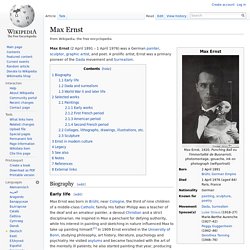
A prolific artist, Ernst was a primary pioneer of the Dada movement and Surrealism. Biography[edit] Early life[edit] Max Ernst was born in Brühl, near Cologne, the third of nine children of a middle-class Catholic family. His father Philipp was a teacher of the deaf and an amateur painter, a devout Christian and a strict disciplinarian. In 1914 Ernst met Hans Arp in Cologne. Leonora Carrington. Leonora Carrington OBE (6 April 1917 – 25 May 2011[1]) was a British-born–Mexican artist, surrealist painter and novelist.

Roberto Matta. Un article de Wikipédia, l'encyclopédie libre. Dorothea Tanning. Tableaux de Roberto Matta. Éternels Éclairs La Biographie Tableaux sélectionnés : Des droits d'auteurs protègent les oeuvres ici présentes ; en cas de réclamation des ayants droit celles-ci seraient immédiatement retirées.
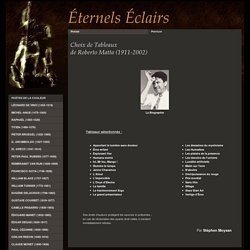
Par Stéphen Moysan. Roberto Matta — The open cube. En entrant dans le « cubo abierto » de Roberto Matta, le spectateur ne peut pas analyser l’œuvre ; il doit se soumettre à la synthèse et accueillir le cube d’un seul tenant, sans divisions, sans fractures ; il doit laisser derrière lui la méthode fragmentaire avec laquelle raisonne son esprit.

Le spectateur ne peut que se laisser submerger par l’œuvre d’art. Où loge la folie A, Où loge la folie B, L’Honniaveuglant, Les Grandes expectatives et Le Où à marée haute sont les cinq toiles qui constituent ce cube ouvert de l’artiste chilien, né en 1911 à Santiago et mort en 2002 à Civitavecchia en Italie. L’idée de ce « cubo abierto » a pris naissance dans la tête de l’artiste dans les années 60 et a pour la première fois été exposé dans les années 70. C’est la première fois, depuis que la fondation Thyssen a acquis les toiles de Matta, que le spectateur peut voir les œuvres comme elles étaient disposées à l’origine.
Reprenons. Giorgio de Chirico. Giorgio de Chirico (Italian: [ˈdʒordʒo deˈkiːriko]; July 10, 1888 – November 20, 1978) was a Greek-born Italian artist.
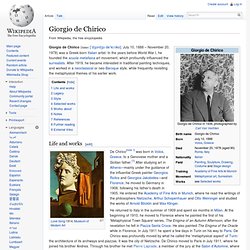
In the years before World War I, he founded the scuola metafisica art movement, which profoundly influenced the surrealists. Tableaux de Giorgio De Chirico. Fabrizio Clerici. Salvador Dalí. Salvador Domingo Felipe Jacinto Dalí i Domènech, 1st Marqués de Dalí de Pubol (May 11, 1904 – January 23, 1989), known as Salvador Dalí (/ˈdɑːli/;[1] Catalan: [səɫβəˈðo ðəˈɫi]), was a prominent Spanish surrealist painter and sculptor born in Figueres, Catalonia, Spain.
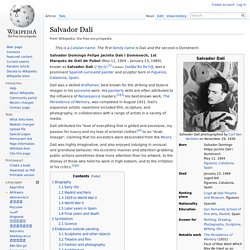
Dalí was a skilled draftsman, best known for the striking and bizarre images in his surrealist work. His painterly skills are often attributed to the influence of Renaissance masters.[2][3] His best-known work, The Persistence of Memory, was completed in August 1931. Dalí's expansive artistic repertoire included film, sculpture, and photography, in collaboration with a range of artists in a variety of media. Dalí attributed his "love of everything that is gilded and excessive, my passion for luxury and my love of oriental clothes"[4] to an "Arab lineage", claiming that his ancestors were descended from the Moors. Tableaux de Salvador Dali. Éternels Éclairs La Biographie Tableaux sélectionnés : Il est recommandé d'aller voir le site officiel. - Aussi : Des droits d'auteurs protègent les oeuvres ici présentes ; en cas de réclamation des ayants droit celles-ci seraient immédiatement retirées.
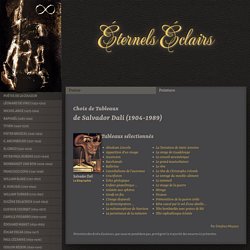
Yves Tanguy. Joan Miró. Earning international acclaim, his work has been interpreted as Surrealism, a sandbox for the subconscious mind, a re-creation of the childlike, and a manifestation of Catalan pride.
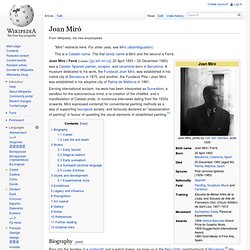
In numerous interviews dating from the 1930s onwards, Miró expressed contempt for conventional painting methods as a way of supporting bourgeois society, and famously declared an "assassination of painting" in favour of upsetting the visual elements of established painting.[1] Biography[edit] John Tunnard. John Samuel Tunnard (7 May 1900 – 12 December 1971) was an English Modernist designer and painter.

He was the cousin of landscape architect Christopher Tunnard. Life[edit] John Tunnard was born in Sandy, Bedfordshire, and educated at Charterhouse School. He studied design at the Royal College of Art (1919–1923). Alexander Calder. Early life[edit] Alexander "Sandy" Calder was born in Lawnton, Pennsylvania on July 22, 1898.
His father, Stirling Calder, was a well-known sculptor who created many public installations, a majority of them in nearby Philadelphia. Sandy Calder's grandfather, sculptor Alexander Milne Calder, was born in Scotland, immigrated to Philadelphia in 1868, and is best known for the colossal statue of William Penn on top of Philadelphia City Hall's tower. Sandy Calder's mother, Nanette (née Lederer), was a professional portrait artist, who had studied at the Académie Julian and the Sorbonne in Paris from around 1888 until 1893. She moved to Philadelphia where she met Stirling Calder while studying at the Pennsylvania Academy of the Fine Arts.
In 1902, Sandy Calder posed nude for his father’s sculpture The Man Cub, which is now located in the Metropolitan Museum of Art in New York City. Alberto Giacometti. Alberto Giacometti (Italian pronunciation: [alˈbɛrto dʒakoˈmetti]; 10 October 1901 – 11 January 1966) was a Swiss sculptor, painter, draughtsman, and printmaker. Alberto Giacometti was born in the canton Graubünden's southerly alpine valley Val Bregaglia and came from an artistic background; his father, Giovanni, was a well-known post-Impressionist painter.
Alberto was the eldest of four children and was interested in art from an early age. Louise Bourgeois. She is recognized today as the founder of confessional art.[4] In the late 1940s, after moving to New York City with her American husband, Robert Goldwater, she turned to sculpture. Though her works are abstract, they are suggestive of the human figure and express themes of betrayal, anxiety, and loneliness. Her work was wholly autobiographical, inspired by her childhood trauma of discovering that her English governess was also her father’s mistress.[4] Life[edit] Sculpture by Bourgeois in the Domestic Incidents group exhibit at London's Tate Modern Turbine Hall, 2006 Early life[edit] Bourgeois was born on 25 December 1911 in Paris, France.[5] She was the third child of four born to parents Josephine Fauriaux and Louis Bourgeois.[6] Her parents owned a gallery that dealt primarily in antique tapestries.
As a child, Bourgeois did not meet her father's expectations due to her lack of ability. Jean Arp. Jean Arp / Hans Arp (16 September 1886 – 7 June 1966) was a German-French, or Alsatian, sculptor, painter, poet and abstract artist in other media such as torn and pasted paper. When Arp spoke in German he referred to himself as "Hans", and when he spoke in French he referred to himself as "Jean". Many people believe that he was born Hans and later changed his name to Jean, but this is not the case. Oeuvres de Jean Arp. Surrealism. Surrealism is a cultural movement that began in the early 1920s, and is best known for its visual artworks and writings. The aim was to "resolve the previously contradictory conditions of dream and reality. " Artists painted unnerving, illogical scenes with photographic precision, created strange creatures from everyday objects and developed painting techniques that allowed the unconscious to express itself and/or an idea/concept.[1] Surrealist works feature the element of surprise, unexpected juxtapositions and non sequitur; however, many Surrealist artists and writers regard their work as an expression of the philosophical movement first and foremost, with the works being an artifact.